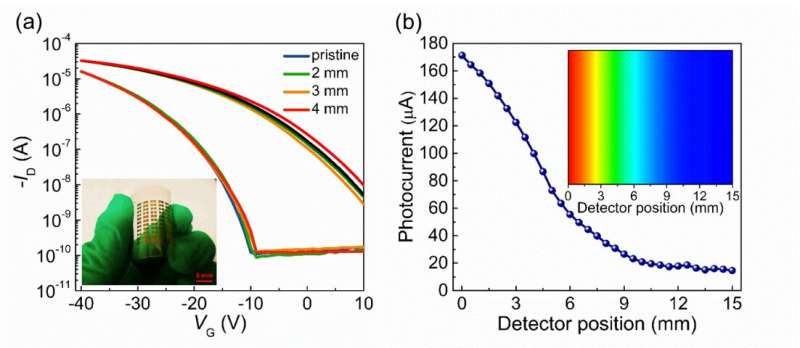Scientists develop ultrasensitive organic phototransistors based on novel hybrid-layered architecture

Organic phototransistors (OPTs) are widely used in environmental/health monitoring, quantum communication, chemical/biomedical sensing, remote control, surveillance, and image sensors since they are lightweight, low-cost, highly efficient and environmentally friendly.
The interfacial charge effect is very crucial for high-sensitivity OPTs. Conventional layered and hybrid OPTs suffer from tradeoffs in balancing the separation, transport, and recombination of photogenerated charges.
Prof. Li Jia and Gao Yuanhong from the Shenzhen Institutes of Advanced Technology (SIAT) of the Chinese Academy of Sciences and their collaborators developed a novel hybrid-layered architecture to improve the overall photodetection performance of organic phototransistors by simultaneously taking advantages of the charge-trapping effect and efficient carrier transport. Their findings were published in Advanced Materials.
The structure of the novel hybrid-layered phototransistor (HL-OPT) consists of a high mobility organic semiconductor channel layer for fast carrier transport, an organic bulk heterojunction (BHJ) photoactive layer, and an ultrathin inorganic interlayer sandwiched in between.
Excitons generated in the photoactive layer dissociated into electrons and holes at the donor/acceptor BHJ. The generated electrons were readily trapped by the acceptors nearby and holes were injected into the channel layer to increase carrier concentration.

An inorganic interlayer was chosen to further enhance hole injection and block electrons, subsequently suppressing electron-hole recombination. As a result, by combining the virtues of the charge-trapping effect and fast carrier transport, significant enhancement in the overall photodetection performance was achieved from the HL-OPT.
To evaluate potential applications of the high-performance HL-OPT, the researchers fabricated the devices on flexible substrates and confirmed their excellent flexibility. Meanwhile, the devices were also integrated into a one-dimensional array and demonstrated the reliability of the HL-OPT in photosensitive imaging systems. "These successful trials make the HL-OPT particularly appealing for applications in flexible and wearable optoelectronic devices," said Prof. Li.
This work provides new insights into the design and optimization of high-performance photodetectors, spanning the ultraviolet and near infrared ranges, and suggests fundamental topics pertaining to electronic and photonic properties of the devices.
"Another exciting point is that this organic photodetector can be potentially fabricated by using printing techniques, which would further reduce the processing cost," said Li. "I hope this work can provide the market with a promising solution for photodetectors by combining both high performance and low cost."
More information: Yuanhong Gao et al, A Novel Hybrid‐Layered Organic Phototransistor Enables Efficient Intermolecular Charge Transfer and Carrier Transport for Ultrasensitive Photodetection, Advanced Materials (2019). DOI: 10.1002/adma.201900763
Journal information: Advanced Materials
Provided by Chinese Academy of Sciences




















